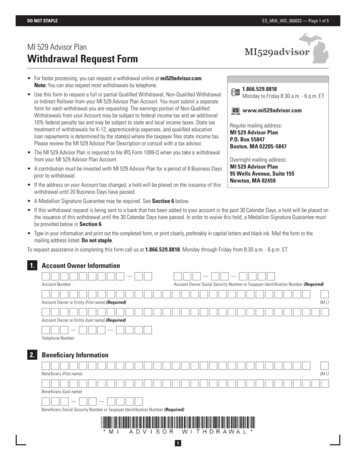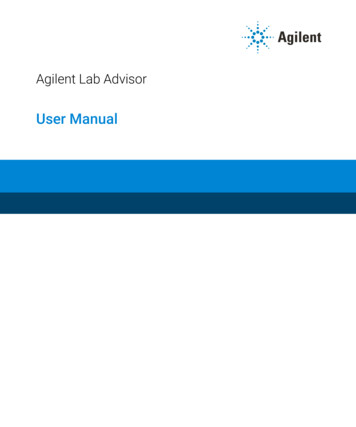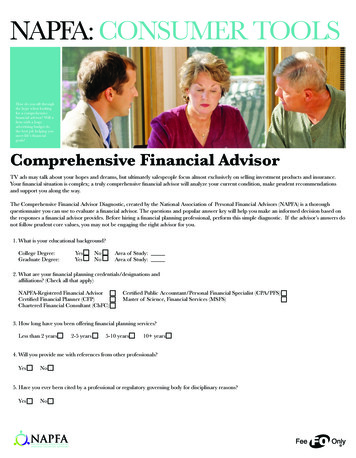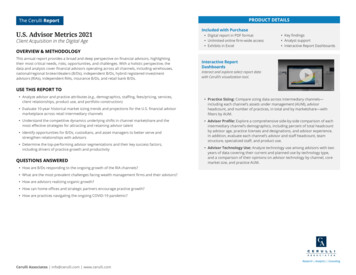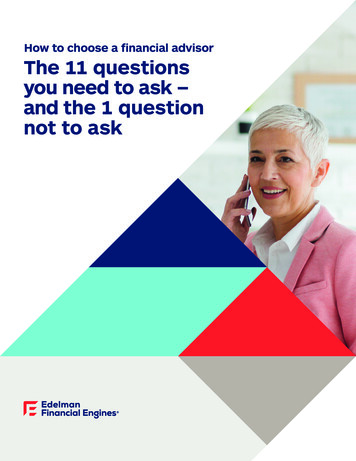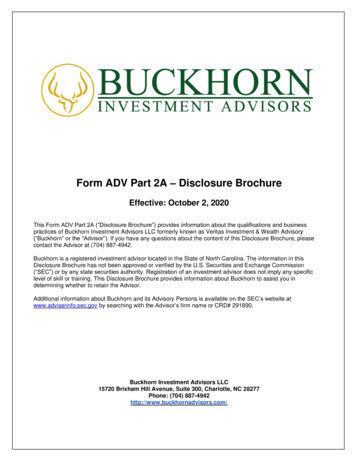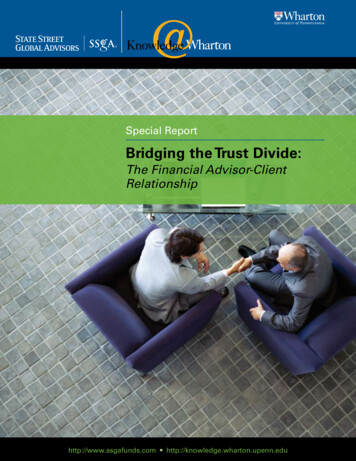
Transcription
Special ReportBridging the Trust Divide:The Financial Advisor-ClientRelationshiphttp://www.ssgafunds.com http://knowledge.wharton.upenn.edu
Table of ContentsI. A Matter of TrustThree Levels of TrustTrust in Technical Competence & Know How333Trust in Ethical Conduct and Character4Trust in Empathic Skills and Maturity4How Advisors Can Damage TrustFuzziness about Fees56Transparency in FeesThe Risks of Transitioning to Transparency77Rationalizing the Fee StructureII. What Advisors Know—and Don’t Know—About Their ClientsKey Research FindingsRespondent DetailsIII. Advisor Best Practices: Building Trust with the Fee DiscussionFour Steps to Success When Discussing FeesConclusion8101014151619
At one time, financial advice usually came folded into another service,sometimes in the form of suggestions from a tax accountant, morefrequently in the form of stock tips offered by a broker-dealer. Often,it was good advice. At times, however, it was conflicted, becausemoving particular products sometimes took precedence over doingwhat was right for the client.Over the last 15 years, that model has changed. First, advances intechnology and regulatory reforms led to the rise of discount brokers,making it difficult for the old-fashioned stockbroker to sustain thesame fee structure. Later, partly in response to that assault, thefinancial services industry looked to develop a more stable and lesscyclical revenue stream. This fit in neatly with consumer concernsabout conflicts of interest, and has led to a new paradigm in financialadvice—the movement toward offering consultative services insteadof product pushes and straightforward fee structures rather thancomplex or opaque ones.In this report, State Street and Knowledge@Wharton look at howfinancial advisors are negotiating the boundaries of this evolvingrelationship. Specifically, the report examines how advisors can:1. Strengthen relationships by engendering trust;2. Best communicate the value they bring to their clientsgiven how clients generally perceive value; and3. Successfully discuss fees with clients.
I. A Matter of TrustAccording to experts at Wharton and a survey of advisors and clients, trust is thefoundation of the advisor–client relationship. Although that might sound elementary,it is evidently overlooked by many advisors. In fact, some advisors take serious riskswhen it comes to cultivating and preserving it through their communication practices,empathic skills, and competence in discussing what can be awkward topics, like feesor sensitive personal and family issues.Charlotte Beyer, CEO of the Institute for Private Investors (IPI) in New York, an educationaland networking group for ultra high net worth individual investors, concedes that, at onetime, wealth management was a business “shrouded in mystery—and very, very highprofit margins.” Since the model has changed, via a transition from product to service,many financial advisors have had to master the art of a new sales tactic. Call it the “salesfree sale”, this approach is now an essential part of every successful advisor’s repertoire.The distinction is noteworthy because there is much less of an emphasis on pitching stocksand mutual funds, and more on personal counseling and education, say Wharton marketingexperts. As with selecting other service providers, such as a family physician, the advisorthe client chooses is frequently the one the client feels she can trust the most.As with selectingother serviceproviders, suchas a familyphysician, theadvisor theclient chooses isfrequently theone the clientfeels she cantrust the most.Three Levels of TrustTrust in Technical Competence & Know HowThere are certain components to trust that every client,consciously or even instinctively, looks for in a financialadvisor. First, by and large, investors are looking forsomeone whose level of competence inspires trust.In other words, an investor generally seeks an advisorwho is experienced and knowledgeable, one who canhelp the investor make, or single-handedly make on theinvestor’s behalf, difficult financial and personal decisions.According to Rachel Croson, professor of operations andinformation management at Wharton, this type of trust isencapsulated by the question, “Do I trust that you knowwhat you’re doing?”This report found that although most advisors believethey understand the importance of trust to the successof the advisor-client relationship quite well, they may
be hurting their credibility by not emphasizing their expertise enough. In Part II of this report, both a survey and afocus group conducted by State Street and Knowledge@Wharton found that there is a sizable gap between the valueconsumers place on expertise and the value advisors place on it. Additionally, and perhaps not coincidentally, a similargap was found between how well clients think their advisors are doing and the advisors’ much higher opinion of theirown performance.But how do you convey expertise to a non-expert? Croson says burying the investor withtalk about means and standard deviations isn’t the way to do it. Neither will the remark:‘Just trust me.’ What’s needed are explanations that are clear and yet not overly simplistic.As with a doctor or lawyer, insists Croson, the financial advisor consumers prize most isthe one who can tell them just enough about the subject.Trust in Ethical Conduct and Character.increasingly thevalue of financialadvice is not reallymanaging themoney, but in the“softer” advisoryelements—personalcounseling andinstruction.While many advisors tend to think of trustworthiness as simply a function of personaland/or industry ethics, Croson believes consumers distill this level of trust into one basicyet critical question: “Do I trust you not to steal money from me?”And this is precisely where an advisor’s reputation comes in. Consumers tend to look wellon advisors who are associated with companies that they have heard of. Advisors whobelong to one of the 10-15 financial service companies that are household names mayhave an edge with many clients, according to Eric Bradlow, a professor of marketing atWharton who teaches marketing strategy to financial advisors. Marketing professor DavidReibstein points out that most of the advertising from the big financial firms is focusedsimply on establishing the firm as part of what marketers call an “evoked set”—the groupthat consumers consider when they think of a given category.Trust in Empathic Skills and MaturityThe final element of trust focuses exclusively on the interpersonal relationship. Dr. JamesGrubman, one of only a handful of specialized psychologists who provide wealth counselingand training services to financial professionals and their clients, confirms that there is athird dimension of trust present in every successful advisor-client relationship. This levelof trust, which we might call relationship competence, may be the most critical becausewithout it, as Grubman points out, the relationship is extremely fragile. Essentially, thistrust is built on the client’s premise that “if I tell you personal things about myself or myfamily, I need to trust that you, the advisor, will handle that well.” / State Street Global Advisors Knowledge@Wharton
Grubman points out that because wealth bringsunexpected stresses to many individuals and families,coping with money issues can be difficult. Many advisorsstruggle with the skills needed to solve the interpersonalissues associated with wealth management. Grubman’sbottom line: clients are more comfortable and morelikely to continue their relationship with advisors who areable to integrate the financial and the personal into theirfinancial advising practices. Those advisors who don’t,will likely face limitations in the advisor-client relationshipfactors together on one weighted scale or in a singlerule. That’s where a trusted advisor comes in: in one ofher surveys, only 15% of respondents said they wouldbe comfortable making a trade-off on a difficult healthcare choice for themselves, but 61% said they wouldbe comfortable with their physician’s use of a similarmodel.and may find that they are ultimately unable to satisfy theclient. Without the personal dimension, or without theclient’s trust in the advisor to handle personal issues andsensitive information with empathy and tact, the clientwill not feel connected to the advisor. Consequently, theadvisor is often unable to get to the heart of a client’sfinancial situation—the personal issues that underlieone’s relationship with money.investment decisions. Since the choices that need to bemade in financial advice are similar to health care issues inthat they are often unpleasant or difficult (such as savingmoney versus spending it now, or taking on additionalrisk versus accepting a lower return), her theory is thatpeople want to find someone who can make those kindsof choices for them. “Because they’re stressful and notfun to think about, they would rather ask a financial agentto make those decisions,” she says.According to Richard Marston, professor of finance atWharton, increasingly the value of financial advice is notreally managing the money, but in the “softer” advisoryelements—personal counseling and instruction. “Theadvisor has to understand the logic behind the adviceand work the argument through with the client so theclient really understands it.”Clients are looking for advisors whom they trustenough—a trust grounded in the rapport established—to make difficult decisions for them. Barbara Kahn, aprofessor of marketing at Wharton, conveys the need issimilar to what people are looking for in their doctors. Inseveral research projects on how consumers make highstake decisions in health care, Kahn found that whileconsumers are good at identifying the most importantfactors to consider, such as quality of life, survival rates,and cost, they tend to have a hard time putting thoseKahn notes that similar results were found whenconsumers were asked to make hypothetical financialHow Advisors Can Damage TrustEven once trust has been established between the clientand the advisor, other variables can serve to compromisethe relationship. As with any relationship, advisors mustunderstand that trust is not a fixed quantity and is easilydiminished. Weak investment returns might seem likethe biggest way in which clients lose confidence in theiradvisor. However, Wharton’s Bradlow contends advisorstend to underrate the importance of professionalismamong every person on the team of staff supporting therelationship.In fact, Bradlow suggests that often times only 15-20% ofthe client’s contact is with the financial advisor; the other80% of the contact is with the advisor’s assistant andsupport staff. Those people are likely to have a very largeimpact on the client’s opinion of the advisor’s brand.
Bradlow argues that professional, well-trained supportstaff are essential, especially with a relatively new client.It can take between six months and a year for people toform a solid sense of an advisor’s persona and brand,and that image can be shattered if multiple sources ofcontact introduce a view that is somehow incongruousor inconsistent with what the advisor has presented.Fuzziness about FeesFees are another critical area where trust can be easilydiminished. The challenges the industry faces with feesare well-documented, but the results of the State Street /Knowledge@Wharton survey suggest that the credibilityof many advisors may be hurt simply because of the waythey are discussing their compensation.In fact, the survey results (see Part II of this report) suggestthat many advisors find fees a difficult subject to discuss.And they’re not alone. Z. John Zhang, a professor ofmarketing at Wharton, agrees: “In all service industries,nobody really wants to talk about the prices. You wantthe customer to focus on the service you provide and theresults that you can deliver. I think for financial advisorsit’s the same.”Ironically, although advisors may try to skirt the issue offees, leading financial advisors interviewed for this reportsay that most of their clients aren’t all that concernedabout the absolute levels of the fees. What they areconcerned about is clarity. This isn’t surprising: Financialadvisors and marketing experts at Wharton suggest thatfor most people, the issue isn’t really whether fees arehigh or low, but that they know what they are.Yet, despite years of negative publicity and controversy,some Wharton scholars are skeptical that consumersare getting as much clarity as they desire from the / State Street Global Advisors Knowledge@Whartonfinancial services industry. “The most important thingis transparency—so people know what is going onunequivocally—and I’m not sure that that’s happening,”says Leonard Lodish, a professor of marketing at Wharton.Fuzziness about fees seems to be endemic at everystratum of the market. Even the ultra-high-net-worthinvestors, who presumably are getting the mostsophisticated advice money can buy, are not satisfiedwith the degree of transparency they are getting fromtheir advisors, according to a recent Institute for PrivateInvestors (IPI) survey.Charlotte Beyer, CEO of IPI, reveals that in the mostrecent survey of members in her organization—who aregenerally worth 50 million or more—a large majorityfelt that while they believe the advice they receiveis objective, they are concerned that they are notgetting quite the full story about the fees they pay forthe service provided.In particular, she says, many members of her organizationexplain that the way advisors present their fees oftenmakes it very difficult for the investors in her group toassess whether one firm is charging more than another.While the intent of such bundling is to keep clients fromseeing the service as a commodity, Beyer argues thatthe practice is ultimately corrosive to the relationship.“If I don’t feel that I completely understand the feestructure and I’m not sure I can compare one firm againstthe other.it puts a little chink in the trust I have.” Andonce that trust begins to erode, she adds, the clientbecomes increasingly vulnerable to being snagged by acompetitor.When attempts are made to clarify fee structures, advisorsshouldn’t discount the potential for confusion or a lack of
understanding of what the fees mean on the client side, either. In a recent study1, former Wharton professor of businessand public policy Brigitte Madrian and two colleagues gave MBA and undergraduate business students prospectuses forfour index funds. One group received an additional “fee sheet” that compared the fees and their impacts on earningsacross the four funds, and another group received a “returns sheet” showing each fund’s average annual returns since thefund was started. The participants were then asked to make hypothetical investments of 10,000, choosing among thefour index funds.Since the funds were identical, the only difference between them was the fees.What Madrian and her colleagues discovered, however, was that the participants“overwhelmingly failed to minimize the index fund fees” by neglecting to put all of theirmoney in the fund with the lowest fee. The students who received the fee sheet didbetter than the others, investing more money in the lower-fee funds. “What we drawfrom this is that disclosure matters,” Madrian says, “but how information is disclosedalso matters.”Beyer predicts that this kind of fuzziness over fees won’t be around forever. “If you thinkabout a lot of other things that you pay for—if you go to buy a car, you know what the bluebook says, you know what the sticker price is. Increasingly, financial services are going tobecome more and more transparent,” she says.Transparency in FeesThe Risks of Transitioning to TransparencyThis lack of transparency in fees has helped make many advisors much more vulnerablethan they realize, claims Mitch Anthony, a Minneapolis-based consultant to the financialadvisory industry. “No matter how much you think you realize the level of distrust overfees, we underestimate it. It’s easy for the industry to say we’re changing the way we dobusiness because we want to build trust with our clients, and then come out with a bunchof touchy-feely ads, but all it does is increase the level of cynicism to the consumer.”Already, some experts believe that the pressure for more transparent pricing is pullingthe market in two directions. “I think it’s increasingly barbell-shaped,” says Wharton’sMarston.The winners, say Marston and others, are increasingly either advisors who offer customservice (typically on a percentage-of-assets basis) or cheaper, almost automated solutions,utilizing some of the increasingly popular low-cost index fund families and exchangetraded funds (ETFs). The losers in the market are those who haven’t adapted to a world“If you thinkabout a lot ofother things thatyou pay for—if you go tobuy a car, youknow what theblue book says,you know whatthe sticker priceis. Increasingly,financial servicesare going tobecome moreand moretransparent.”1 Choi, James J., Laibson, David I. and Madrian, Brigitte C., “Why Does the Law of One Price Fail? An Experiment on Index Mutual Funds” (May 2006). NBER Working Paper No. W12261 Available at SSRN:http://ssrn.com/abstract 905518
divided between providers of higher-fee, custom-tailoredservices and inexpensive solutions geared for the massmarket. “The people who rely on current sales of stockand so on are having problems,” insists Marston.Much of the industry is already proceeding on this theory.Many wirehouses, for example, have developed bothonline and full-service options, with the intent of trying toreach both ends of the market. Others have respondedby making acquisitions, either of discount brokers at oneend or trust service providers at the other, to reach thefull spectrum of the market.Another sign that financial services firms are aware ofthis change is that their training programs are evolving.At one time, Marston adds, advisors were taught howto sell a stock or a bond, and not much more. “Thosedays are over,” he says. “These firms are becoming muchmore sophisticated in their training.”To make sure that their advisors are going to be able tosatisfy the increasing demands of their high-end clients,a number of firms are spending enormous amounts ofmoney educating their advisors, according to Marston.Some of the largest firms are even paying for tuitionthat will enable their financial professionals to earn aprofessional credential, such as a CFP (Certified FinancialPlanner) designation, he says.Rationalizing the Fee StructureIn courting new clients, the shift to a fee-only model is achallenging one for firms and advisors alike, professorssay. One of the biggest hurdles is learning to articulateto the client what services they are actually getting inexchange for their fee or for an annual percentage ofassets. This may be particularly the case in high-endaccounts, if the advisor is no longer picking the stocks, / State Street Global Advisors Knowledge@Whartonbut picking managers. If that’s the case, what is theadvisor actually adding? One way to address this issue,Marston contends, is to create rigorous methods forchoosing managers. “It’s a much more serious businessthan it used to be,” he says.But what if the advisor is just buying index funds or ETFs,which the client could buy through a broker relatively easilyand cheaply? How can the advisor justify the right to anannual percentage of assets for as long as that relationshipcontinues? Easily, in Marston’s view. He believes that thereis actually a lot of value being created by the advisor evenwhen nothing is happening in the portfolio. “My belief isthat the number-one source of value added is getting theclient into the portfolio and keeping them invested throughdifferent market cycles,” he says.A lot of evidence supports Marston’s view that manyinvestors need to be kept from acting on behavioralbiases. “It’s well known that people think they arebetter at basically doing anything than they actually are,”maintains Wharton’s Croson. Investing is no different.At the same time, advisors shouldn’t be afraid to alerttheir clients to the mistakes they may be making withinthe self-directed portions of their portfolios. This type ofconsult can provide the advisor with an anecdote thatassists them in legitimizing their fees. A study conductedby Wharton professor of insurance and risk managementOlivia Mitchell and several co-authors further illustratesthe consequences resulting from investors not managingtheir portfolios actively enough. The study found that theaverage 401(k) account contains only 3.5 funds out of whatis on average a set of 18 available funds—and 80% of thesample never traded at all over a two-year period. In fact,average turnover for a professional is about 117% whileamong the faster-trading 401(k) subscribers, it’s more like
24%. While that is undoubtedly better than daytrading,such ultra-low turnover may carry its own set of risks:“For the overwhelming majority of retirement savers,there is no evidence of portfolio rebalancing, shifts in risktolerance with age, or tactical portfolio changes.”2A trusted advisor can also add value by framing investmentchoices around a manageable number of options, becausethe evidence indicates that individual investors have adifficult time when faced with too many choices. A studyof the investment choices of 857,000 employees of 657different companies found that participation declined asthe number of funds offered by their 401(k) plans grew.For every ten option increase, participation in the programdeclined by 2% on average, despite financial incentivesto participate.3One factor that Glenn Frank, a senior investment strategistfor Calibre Advisory Services, Inc., a unit of WachoviaWealth Management, of Waltham, Massachusetts, keepsin mind is that for some clients, convenience is a majorreason they send their money to be managed by someoneelse. It’s similar to how they might feel about plumbing,suggests Frank, who in 2006 was ranked as one ofWorth Magazine’s 100 top advisors: “Gee, I can do myown plumbing, but I’d probably get all wet and I’d pay morefor parts.”However clear the need for an objective, non-emotionaladvisor may be, Marston concedes that clients may notlike the idea that they are really buying a kind of financialcaretaker. “The client is not going to be willing to pay a feefor tying the client’s hands,” Marston says. Therefore, increating the perception of value, he argues, many advisorsfind it easier to convince clients that they are adding valueby choosing good managers—though conventional wisdomindicates that the vast majority of actively-managed largecap funds underperform the index.Framing value in this way has its obvious limits. Today’sinvestor is becoming more and more sophisticated, bothin terms of his access to investment research and hisability to manage a portfolio, which means that proposingthat the primary value an advisor brings to a relationshipis that of manager selection may not work over the longterm. Advisors need to move toward offering their clientsa consultative approach to financial management—onethat blends the financial aspects of the relationship withthe personal.In this way, with the right communication skills andtools, the advisor adds real value by focusing not onlyon a client’s financial well-being, but on the underlyingpersonal and familial issues that could further promoteor cripple the client’s financial health. These are often theissues a client is unaware of, or reluctant to face, due toanxiety or embarrassment. Experts and the State Street /Knowledge@Wharton survey suggest, however, that anadvisor who is able to build and preserve trust on all threelevels—competence, ethics and empathic skills—is in abetter position to help clients face these issues head-onand create more satisfying and long-lasting relationshipswith them.Part II of our report offers empirical evidence on preciselywhat financial advisory clients are looking for from theiradvisors. The results may be surprising to some, but theyreinforce what Wharton professors and other industryexperts believe—that clients want straight talk from atrusted professional.2 Mitchell, Olivia S., Mottola, Gary R., Utkus, Stephen P. and Yamaguchi, Takeshi, “The Inattentive Participant: Portfolio Trading Behavior in 401(k) Plans” (2006). Available at SSRN:http://ssrn.com/abstract 8818543 Sheena Sethi-Iyengar, et al., “How Much Choice is Too Much? Contributions to 401(k) Retirement Plans,” Pension Design and Structure: New Lessons from Behavioral Finance, 83-95. Oxford: OxfordUniversity Press. (2004)
II. What Advisors Know—and Don’t Know—About Their ClientsAlthough clients desire clearer communication from their advisors, the findings of a survey of financial advisors and,separately, affluent individuals, conducted for this report found that many advisors’ relationships are much shakier thanthey believe.The survey, conducted by State Street and Knowledge@Wharton to assess the strength of the client-advisor relationship,revealed a material gap between advisors’ perceptions about their client relationships and the clients’ perceptions ofthose relationships. While people are notoriously likely to discount the importance of emotional factors such as congenialpersonality in their choice of professional relationships, this discrepancy may still be a cause for concern for advisors andfor the marketers of advisory services— particularly as clients surveyed rated advisors’ performance about half as highlyas advisors themselves believe their clients rate them. And that may place some advisors at risk.Key findings of the research follow:Fees are an area of miscommunication betweenadvisors and clientsFigure 1In both the focus group and the survey, fees were revealedto be an area where there is a wide gap between whatadvisors say and what their clients hear.The actual degree of communication advisors and clientshave about fees is unclear. Almost all advisors surveyed(95%) indicated they discuss their fees with their clients;yet, only 61% of customers say that their advisor initiatesfee discussions with them.fees. “It’s almost like they want to believe that this issomething that’s understood. If you believe that it’salready been covered, then you don’t have to do it.”Figure 1: Communication about fees:The Frequency of Fee Discussions (Present 0%QuarterlyadvisoryearlyOnce every2-5 yearsWhen AnIssue ArisesClient Raisesthe SubjectclientWhy the gap in perception between advisors and clientson the issue? Bradlow believes it’s wishful thinking onthe part of advisors who are uncomfortable discussingFor a graphical depiction of the complete set of raw survey results (advisors and clients), visitwww.ssgafunds.com.10 / State Street Global Advisors Knowledge@Wharton
Ironically, although advisors presumably don’t discussfees out of fear of scaring away clients, the clients whoparticipated in a State Street focus group agreed thatthey would prefer knowing. “I have more of a problemwith not knowing,” said one woman.Figure 3: Receiving Fair Value for services provided100%80%60%52%40%36%Figures 2 & 3Perhaps as a result of this lack of contact, only a minorityof advisors surveyed believe their clients understand theirfee structure fairly well or completely. Clients confirmedthat they generally do not understand their advisor’s SatisfiedadvisorSatisfiedSomewhatSatisfiedNot at allclientstructures all that well.Trust is essentialFigure 2: understanding the fee structure:How well do they understand?Figure 4Among advisors, more than two-thirds ranked trustworthiness as the most important attribute in the selectionof a financial advisor. For clients, trust is also the keyelement (69%).100%80%60%Figure 4: The Importance of trust:Most important characteristics of a financial isor6%100%Not at all80%3%0%Fairly %40%Most advisors said they believed their clients felt thatthey were receiving a fair value for the fees they paid.Most clients are, in fact, relatively satisfied with the valuethey receive for the fees they pay, but generally less sothan advisors think.In addition, costs matter much more to clients thanadvisors believe. A striking 41% of advisors believed thatcost was their clients’ least important concern. Althoughstill the lowest-ranked factor, reasonable cost wasbelieved to be an important aspect (rated as one of thetop two most important attributes) by 31% of clients.24%20%20%13%16%0%12%10%4%5%Low costTrustworthiness understands Communication Performancepracticesfor servicesFamily Needsprovidedand GoalsadvisorclientKnowledge is more important thanadvisors thinkFigure 5Another discrepancy between advisors and clients is thedifferent weight they place on knowledge. While only26% of advisors ranked knowledge as a top attribute,nearly half of all clients gave it their highest rating.11
But advisors don’t have much time toquell clients’ doubtsFigure 5: The Importance of knowledge:the most important attributes to serving clients wellFigures 7-10100%One challenge for advisors in correcting some of thesepreconceptions is that their clients don’t actually want tocommunicate more with them than they already do. Theburden, then, is on the quality of the communication andnot necessarily the 15%13%Figure 7: current Frequency of StableTransparent Responsive100%advisorclient80%Some members of the focus group also saw competenceas extremely important—and ignorance as nearly a dealbreaker. In the focus group, for instance, one womanwho was asked to sell some holdings before she movedher account to a new firm, said t
How Advisors Can Damage Trust 5 Fuzziness about Fees 6 Transparency in Fees 7 The Risks of Transitioning to Transparency 7 Rationalizing the Fee Structure 8 II. What Advisors Know—and Don't Know—About Their Clients 0 Key Research Findings 0 Respondent Details 4 III. Advisor Best Practices: Building Trust with the Fee Discussion 5



